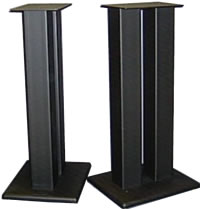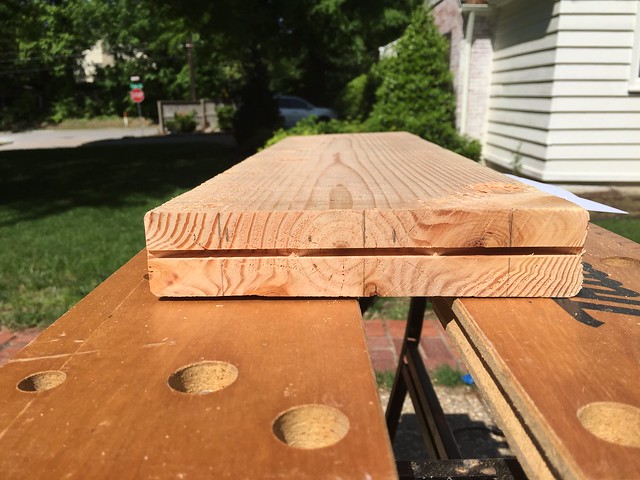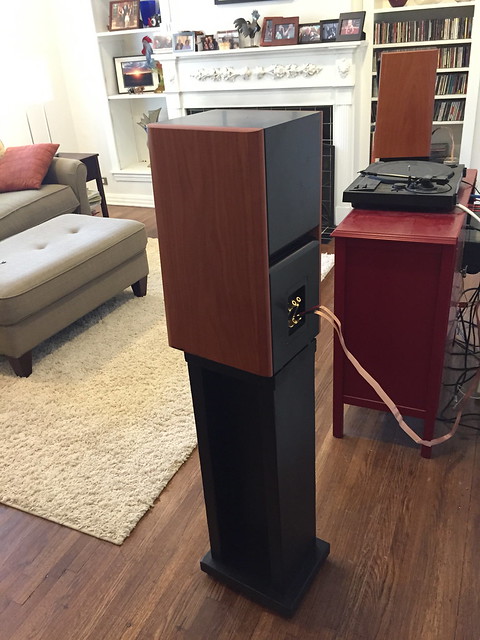I just picked up a pair of MTM speakers and will be making stands for them once I figure out the optimal height.
Planning to get a small piece of 3/4" plywood to make the bases (~10" x 12") and the speaker mounts (~6" x 7") with either 2 or 4 columns between them. The idea is to make them look like these 2-column or 4-column stands by Target:

For the columns, do you think 2" x 6" or 4" x 4" pine lumber would be OK? Too much resonance, risk of warping? Or might it be better to cut several strips of plywood and glue them together to form the columns?
Thanks,
Jeff
Planning to get a small piece of 3/4" plywood to make the bases (~10" x 12") and the speaker mounts (~6" x 7") with either 2 or 4 columns between them. The idea is to make them look like these 2-column or 4-column stands by Target:

An externally hosted image should be here but it was not working when we last tested it.
For the columns, do you think 2" x 6" or 4" x 4" pine lumber would be OK? Too much resonance, risk of warping? Or might it be better to cut several strips of plywood and glue them together to form the columns?
Thanks,
Jeff
Hollow plywood posts, 4" diam Schedule 40 plumbing pipe or whatever, you certainly want to ensure that the effective mass of the stand is at least that of the speakers, or risk them tipping over. 😱 yup, I've done that
Andersonix make a very good suggestion - sand, lead shot, glass sand blasting media are all materials I've used to deaden resonances and anchor speaker stands and Sound Organization equipment stands.
The Target stands work very well, but aren't cheap. It'd be pretty easy to make a DIY version of the Paradigm 2 post stands - filled plumbing pipe bolted with ready rod, nuts counter sunk into base and top plate, glued to off cut of granite or quartz stone stone from kitchen countertop fabricator, and felt pads or rubber feet for hard floors. Having ruined more than my fair share of carpets and hardwood / vinyl floors, I'm no fan of spikes.
A few dabs of BluTak on the top plate can't hurt either.
Andersonix make a very good suggestion - sand, lead shot, glass sand blasting media are all materials I've used to deaden resonances and anchor speaker stands and Sound Organization equipment stands.
The Target stands work very well, but aren't cheap. It'd be pretty easy to make a DIY version of the Paradigm 2 post stands - filled plumbing pipe bolted with ready rod, nuts counter sunk into base and top plate, glued to off cut of granite or quartz stone stone from kitchen countertop fabricator, and felt pads or rubber feet for hard floors. Having ruined more than my fair share of carpets and hardwood / vinyl floors, I'm no fan of spikes.
A few dabs of BluTak on the top plate can't hurt either.
Last edited:
I've been thinking over this project for the past ten days or so. Still considering making hollow plywood columns to fill with sand. However, since mass-related floor coupling was a problem with my last pair of speakers (for which I went to great lengths to isolate), my instinct is to keep it light but rigid. The total stand height needs to be around 26".
Here are a few more ideas. Any thoughts on these would be much appreciated.
(1) Clone of the 4-column stand (above) using yellow pine or douglas fir 2 x 4's (which are really more like 1.5" x 3.5"), with the base and top plate made either of 3/4" plywood, yellow pine, or doug fir (inexpensive and easily available at home improvement stores). The columns would be attached to the base and top plate with biscuits, screws, and glue.
(2) Rigidity and stability might be achieved with a kind of i-beam column made of 2 x 6 boards (fir or yellow pine): 1 in the front, 1 in the back, joined by a perpendicular one glued and biscuited to their center lines. Then the assembly could be biscuited, glued, and screwed to the base and top plate (again, ply or yellow pine/doug fir). It would look like this, only with all 90* angles and 26" tall, and with thicker boards.

(3) Since softwoods might be too resonant (would they?), perhaps I could make the i-beam design with solid maple boards (been looking into wood characteristics and maple seems to have a very high modulus of elasticity [MOE], meaning it is very stiff). Maple (as well as Oak, Cherry, and other hard woods) is available in 1" thick planks of varying widths. It would look something like this:

Do these ideas seem viable? It would be easy enough to build a sand-filled column, but I'm afraid it might be too deadening (is there such a thing?) or so heavy that I have the same problem with too many vibrations getting transmitted into the wood floor like my old speakers did.
Also, any thoughts about using biscuits in this application? Never used them before but I'm currently holding someone's plate joiner with permission to use it, and I just wanna try it. Alternatively, for the i-beam design I could borrow a relative's router and cut dadoes to allow the middle plank to insert and glue into the front and back ones. That might get better rigidity.
Here are a few more ideas. Any thoughts on these would be much appreciated.
(1) Clone of the 4-column stand (above) using yellow pine or douglas fir 2 x 4's (which are really more like 1.5" x 3.5"), with the base and top plate made either of 3/4" plywood, yellow pine, or doug fir (inexpensive and easily available at home improvement stores). The columns would be attached to the base and top plate with biscuits, screws, and glue.
(2) Rigidity and stability might be achieved with a kind of i-beam column made of 2 x 6 boards (fir or yellow pine): 1 in the front, 1 in the back, joined by a perpendicular one glued and biscuited to their center lines. Then the assembly could be biscuited, glued, and screwed to the base and top plate (again, ply or yellow pine/doug fir). It would look like this, only with all 90* angles and 26" tall, and with thicker boards.
(3) Since softwoods might be too resonant (would they?), perhaps I could make the i-beam design with solid maple boards (been looking into wood characteristics and maple seems to have a very high modulus of elasticity [MOE], meaning it is very stiff). Maple (as well as Oak, Cherry, and other hard woods) is available in 1" thick planks of varying widths. It would look something like this:
Do these ideas seem viable? It would be easy enough to build a sand-filled column, but I'm afraid it might be too deadening (is there such a thing?) or so heavy that I have the same problem with too many vibrations getting transmitted into the wood floor like my old speakers did.
Also, any thoughts about using biscuits in this application? Never used them before but I'm currently holding someone's plate joiner with permission to use it, and I just wanna try it. Alternatively, for the i-beam design I could borrow a relative's router and cut dadoes to allow the middle plank to insert and glue into the front and back ones. That might get better rigidity.
Last edited:
Why not just make them the same rectangular profile as the main speakers? That would look sleeker and then you could put subs in there later once you get all the sand out.
The speakers finally arrived yesterday. Sound great but need damping because of the room response. So now I'm leaning toward hollow, sand-filled columns.
Any sense of whether it's better to make them out of 1" (actual 0.75") thick hardwood boards or 2" (actual 1.5") softwood ones? Or would plywood be better?
Any sense of whether it's better to make them out of 1" (actual 0.75") thick hardwood boards or 2" (actual 1.5") softwood ones? Or would plywood be better?
The stands I made several years ago for smaller speakers look a lot like the second picture in post #4, and they work great.
The spines are filled with quickrete, though.
The spines are filled with quickrete, though.
Quickrete. That's an idea. I looked at cinder blocks, which are dirt cheap and seem like they'd be awesome as speaker stands. Just don't care for the look. So maybe concrete-filled wood is the way to go.
I looked at maple and oak boards at the lumber yard today. They're only available in 0.75" thickness, which didn't seem sturdy enough to me. So I'm going to make a fillable doug fir i-beam.
I looked at maple and oak boards at the lumber yard today. They're only available in 0.75" thickness, which didn't seem sturdy enough to me. So I'm going to make a fillable doug fir i-beam.
Yeah, I went with quickrete because it was cheap, and once it hardens inside there, that's it, it's pretty much glued in place forever. I've got a pair of old kenwood speakers from the 70s sitting on them right now that are about 3 times wider, and they're solid.
The stands are under way, using douglas fir 2x6 boards for the i-beam column and top plate and 2x10 for the base plate. I had to make a router edge guide to cut the grooves, and it works great! The middle boards fit snugly inside and are now gluing with Tite Bond III under clamps. Tomorrow I'll drill the holes in the base and top plates and cut the biscuit slots.










I ended up ruining the ends of the first i-beams because I didn't flush them before gluing. The pieces were too big to rectify with power tools like a band saw, table saw, or table plane.
Turned out it was a lucky mistake because it allowed me to start over with 2x8s, which are a much better size for these speakers than the 2x6s were.
They turned out pretty well -- glued, screwed, and biscuited together, finished with two coats of all-in-one semi-gloss black primer/paint -- but definitely have their flaws.
Now I know why people don't make furniture with framing lumber.
Still, they're level and stable, and provide enough mass and rigidity to absorb mechanical vibration (the sorbothane pads help with that) and allow good clarity, detail, and imaging.
 Finished stands by jeffdrouin, on Flickr
Finished stands by jeffdrouin, on Flickr
 I-beam web biscuit slots by jeffdrouin, on Flickr
I-beam web biscuit slots by jeffdrouin, on Flickr
 I-beam web biscuits by jeffdrouin, on Flickr
I-beam web biscuits by jeffdrouin, on Flickr
 I-beam end by jeffdrouin, on Flickr
I-beam end by jeffdrouin, on Flickr
 I-beam flange groove and top plate biscuit slots by jeffdrouin, on Flickr
I-beam flange groove and top plate biscuit slots by jeffdrouin, on Flickr
 I-beam partial assembly by jeffdrouin, on Flickr
I-beam partial assembly by jeffdrouin, on Flickr
 Routing the flange groove to fit the web by jeffdrouin, on Flickr
Routing the flange groove to fit the web by jeffdrouin, on Flickr
 Gluing i-beams with clamps and bricks by jeffdrouin, on Flickr
Gluing i-beams with clamps and bricks by jeffdrouin, on Flickr
 Top plate and bottom plate, screw pilot holes and threaded floor spike inserts by jeffdrouin, on Flickr
Top plate and bottom plate, screw pilot holes and threaded floor spike inserts by jeffdrouin, on Flickr
 Wood glue and tooth picks to get screws to bite by jeffdrouin, on Flickr
Wood glue and tooth picks to get screws to bite by jeffdrouin, on Flickr
 Assembly completed by jeffdrouin, on Flickr
Assembly completed by jeffdrouin, on Flickr
 Floor spikes by jeffdrouin, on Flickr
Floor spikes by jeffdrouin, on Flickr
 Floor spikes and receiving cups by jeffdrouin, on Flickr
Floor spikes and receiving cups by jeffdrouin, on Flickr
 Assembled stands with sorbothane pads on top by jeffdrouin, on Flickr
Assembled stands with sorbothane pads on top by jeffdrouin, on Flickr
 Assembled stands with speakers mounted by jeffdrouin, on Flickr
Assembled stands with speakers mounted by jeffdrouin, on Flickr
 Assembled stands with speakers mounted by jeffdrouin, on Flickr
Assembled stands with speakers mounted by jeffdrouin, on Flickr
 Painting the stands by jeffdrouin, on Flickr
Painting the stands by jeffdrouin, on Flickr
 Painted stand by jeffdrouin, on Flickr
Painted stand by jeffdrouin, on Flickr
 Finished stands with speakers mounted by jeffdrouin, on Flickr
Finished stands with speakers mounted by jeffdrouin, on Flickr
 Finished stands by jeffdrouin, on Flickr
Finished stands by jeffdrouin, on Flickr
 Finished stands by jeffdrouin, on Flickr
Finished stands by jeffdrouin, on Flickr
 Finished stands by jeffdrouin, on Flickr
Finished stands by jeffdrouin, on Flickr
 Finished stand by jeffdrouin, on Flickr
Finished stand by jeffdrouin, on Flickr
 Stands from behind by jeffdrouin, on Flickr
Stands from behind by jeffdrouin, on Flickr
 Finished stand, close up by jeffdrouin, on Flickr
Finished stand, close up by jeffdrouin, on Flickr
Turned out it was a lucky mistake because it allowed me to start over with 2x8s, which are a much better size for these speakers than the 2x6s were.
They turned out pretty well -- glued, screwed, and biscuited together, finished with two coats of all-in-one semi-gloss black primer/paint -- but definitely have their flaws.
Now I know why people don't make furniture with framing lumber.
Still, they're level and stable, and provide enough mass and rigidity to absorb mechanical vibration (the sorbothane pads help with that) and allow good clarity, detail, and imaging.
 Finished stands by jeffdrouin, on Flickr
Finished stands by jeffdrouin, on Flickr I-beam web biscuit slots by jeffdrouin, on Flickr
I-beam web biscuit slots by jeffdrouin, on Flickr I-beam web biscuits by jeffdrouin, on Flickr
I-beam web biscuits by jeffdrouin, on Flickr I-beam end by jeffdrouin, on Flickr
I-beam end by jeffdrouin, on Flickr I-beam flange groove and top plate biscuit slots by jeffdrouin, on Flickr
I-beam flange groove and top plate biscuit slots by jeffdrouin, on Flickr I-beam partial assembly by jeffdrouin, on Flickr
I-beam partial assembly by jeffdrouin, on Flickr Routing the flange groove to fit the web by jeffdrouin, on Flickr
Routing the flange groove to fit the web by jeffdrouin, on Flickr Gluing i-beams with clamps and bricks by jeffdrouin, on Flickr
Gluing i-beams with clamps and bricks by jeffdrouin, on Flickr Top plate and bottom plate, screw pilot holes and threaded floor spike inserts by jeffdrouin, on Flickr
Top plate and bottom plate, screw pilot holes and threaded floor spike inserts by jeffdrouin, on Flickr Wood glue and tooth picks to get screws to bite by jeffdrouin, on Flickr
Wood glue and tooth picks to get screws to bite by jeffdrouin, on Flickr Assembly completed by jeffdrouin, on Flickr
Assembly completed by jeffdrouin, on Flickr Floor spikes by jeffdrouin, on Flickr
Floor spikes by jeffdrouin, on Flickr Floor spikes and receiving cups by jeffdrouin, on Flickr
Floor spikes and receiving cups by jeffdrouin, on Flickr Assembled stands with sorbothane pads on top by jeffdrouin, on Flickr
Assembled stands with sorbothane pads on top by jeffdrouin, on Flickr Assembled stands with speakers mounted by jeffdrouin, on Flickr
Assembled stands with speakers mounted by jeffdrouin, on Flickr Assembled stands with speakers mounted by jeffdrouin, on Flickr
Assembled stands with speakers mounted by jeffdrouin, on Flickr Painting the stands by jeffdrouin, on Flickr
Painting the stands by jeffdrouin, on Flickr Painted stand by jeffdrouin, on Flickr
Painted stand by jeffdrouin, on Flickr Finished stands with speakers mounted by jeffdrouin, on Flickr
Finished stands with speakers mounted by jeffdrouin, on Flickr Finished stands by jeffdrouin, on Flickr
Finished stands by jeffdrouin, on Flickr Finished stands by jeffdrouin, on Flickr
Finished stands by jeffdrouin, on Flickr Finished stands by jeffdrouin, on Flickr
Finished stands by jeffdrouin, on Flickr Finished stand by jeffdrouin, on Flickr
Finished stand by jeffdrouin, on Flickr Stands from behind by jeffdrouin, on Flickr
Stands from behind by jeffdrouin, on Flickr Finished stand, close up by jeffdrouin, on Flickr
Finished stand, close up by jeffdrouin, on Flickr
Last edited:
This is a interesting concept:
Jean-Marie Reynaud Créateur d'enceintes acoustiques hautes performances
http://www.jm-reynaud.com/jmr/pdf/119.pdf
In this french forum made a 'clone'. One of the participants solicite the plans to JMR, and JMR send the plans of the first version, I suppsed that also is good:
http://www.homecinema-fr.com/forum/general/magic-stand-diy-t29862972-30.html
http://www.fichier-pdf.fr/2012/06/14/magic-stand/magic-stand.pdf
http://www.fichier-pdf.fr/2012/06/14/magic/magic.pdf
Jean-Marie Reynaud Créateur d'enceintes acoustiques hautes performances
http://www.jm-reynaud.com/jmr/pdf/119.pdf
In this french forum made a 'clone'. One of the participants solicite the plans to JMR, and JMR send the plans of the first version, I suppsed that also is good:
http://www.homecinema-fr.com/forum/general/magic-stand-diy-t29862972-30.html
http://www.fichier-pdf.fr/2012/06/14/magic-stand/magic-stand.pdf
http://www.fichier-pdf.fr/2012/06/14/magic/magic.pdf
An externally hosted image should be here but it was not working when we last tested it.
Last edited:
- Status
- Not open for further replies.
- Home
- Design & Build
- Construction Tips
- Speaker Stands